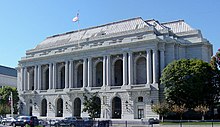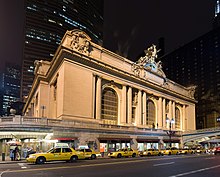Beaux-Arts architecture

Beaux-Arts architecturea[›] (English: /(ˌ)bəʊˈzɑː/, French: [bo.zaːʁ]) expresses the academic neoclassical architectural style taught at the École des Beaux-Arts in Paris. The style "Beaux Arts" is above all the cumulative product of two-and-a-half centuries of instruction under the authority, first, of the Académie royale d'architecture (1671–1793), then, following the French Revolution of the late 18th century, of the Architecture section of the Académie des Beaux-Arts (1795— ). The organization under the Ancien Régime of the competition for the Grand Prix de Rome in architecture, offering a chance to study in Rome, imprinted its codes and aesthetic on the course of instruction, which culminated during the Second Empire (1850–1870) and the Third Republic that followed. The style of instruction that produced Beaux-Arts architecture continued without major interruption until 1968.[1]
The Beaux-Arts style heavily influenced US architecture in the period from 1880 to 1920.[2] Non-French European architects of the period 1860–1914 tended to gravitate towards their own national academic centers rather than fixating on Paris. British architects of Imperial classicism, in a development culminating in Sir Edwin Lutyens's New Delhi government buildings, followed a somewhat more independent course, owing to the cultural politics of the late 19th century.
Contents |
[edit] Training

The Beaux-Arts training emphasized the mainstream examples of Imperial Roman architecture between Augustus and the Severan emperors, Italian Renaissance and French and Italian Baroque models especially, but the training could then be applied to a broader range of models: Quattrocento Florentine palace fronts or French late Gothic. American architects of the Beaux-Arts generation often returned to Greek models, which had a strong local history in the American Greek Revival of the early 19th century. For the first time, repertories of photographs supplemented meticulous scale drawings and on-site renderings of details.
Some aspects of Beaux-Arts approach could degenerate into mannerisms. Beaux-Arts training made great use of agrafes, clasps that links one architectural detail to another; to interpenetration of forms, a Baroque habit; to "speaking architecture" (architecture parlante) in which supposed appropriateness of symbolism could be taken to literal minded extremes.
Beaux-Arts training emphasized the production of quick conceptual sketches, highly-finished perspective presentation drawings, close attention to the program, and knowledgeable detailing. Site considerations tended towards social and urbane contexts.[3]
All architects-in-training passed through the obligatory stages — studying antique models, constructing analos, analyses reproducing Greek or Roman models, "pocket" studies and other conventional steps— in the long competition for the few desirable places at the Académie de France à Rome (housed in the Villa Medici) with traditional requirements of sending at intervals the presentation drawings called envois de Rome.
[edit] Characteristics

Beaux-Arts architecture depended on sculptural decoration along conservative modern lines, employing French and Italian Baroque and Rococo formulas combined with an impressionistic finish and realism. In the façade shown to the right, Diana grasps the cornice she sits on in a natural action typical of Beaux-Arts integration of sculpture with architecture.
Slightly overscaled details, bold scuptural supporting consoles, rich deep cornices, swags and sculptural enrichments in the most bravura finish the client could afford gave employment to several generations of architectural modellers and carvers of Italian and Central European backgrounds. A sense of appropriate idiom at the craftsman level supported the design teams of the first truly modern architectural offices.
Though the Beaux-Arts style embodies an approach to a regenerated spirit within the grand traditions rather than a set of motifs, principal characteristics of Beaux-Arts architecture included:
- Flat roof[2]
- Rusticated and raised first story[2]
- Hierarchy of spaces, from "noble spaces"—grand entrances and staircases— to utilitarian ones
- Arched windows[2]
- Arched and pedimented doors[2]
- Classical details:[2] references to a synthesis of historicist styles and a tendency to eclecticism; fluently in a number of "manners"
- Symmetry[2]
- Statuary,[2] sculpture (bas-relief panels, figural sculptures, sculptural groups), murals, mosaics, and other artwork, all coordinated in theme to assert the identity of the building
- Classical architectural details:[2] balustrades, pilasters, garlands, cartouches, with a prominent display of richly detailed clasps (agrafes), brackets and supporting consoles
- Subtle polychromy
[edit] History
| This section requires expansion. |
On the eve of World War I the Beaux-Arts style began to find major competitors among the architects of Modernism and the nascent International Style. The prestige of the École gave the style "Beaux-Arts" a second wind in combining the new manner with the traditional training.
[edit] Beaux-Arts in France
| This section requires expansion. |
[edit] Parisian buildings in the Beaux-Arts style
- École des Beaux-Arts
- LeFuel wings of the Louvre
- Opéra Garnier.
- Palais du Trocadéro.
- Gare d'Orsay.
- Grand Palais, Petit Palais and the Pont Alexandre III.
- Palais de Chaillot.
[edit] Beaux-Arts in the United States
The first American architect to attend the École des Beaux-Arts was Richard Morris Hunt, followed by Henry Hobson Richardson. They were followed by an entire generation. Henry Hobson Richardson absorbed Beaux-Arts lessons in massing and spatial planning, then applied them to Romanesque architectural models that were not characteristic of the Beaux-Arts repertory. His Beaux-Arts training taught him to transcend slavish copying and recreate in the essential, fully digested and idiomatic manner of his models. Richardson evolved a highly personal style (Richardsonian Romanesque) freed of historicism that was influential in early Modernism.[4]
The "White City" of the World's Columbian Exposition of 1893 in Chicago was a triumph of the movement and a major impetus for the short-lived City Beautiful movement in the United States. Beaux-Arts city planning, with its Baroque insistence on vistas punctuated by symmetry, eye-catching monuments, axial avenues, uniform cornice heights, a harmonious "ensemble" and a somewhat theatrical nobility and accessible charm, embraced ideals that the ensuing Modernist movement decried or just dismissed.[5] The first US university to institute a Beaux-Arts curriculum was MIT in 1893, when the French architect, Constant-Désiré Despradelles was brought to MIT to teach. Subsequently the Beaux-Arts curriculum was begun at Columbia University, The University of Pennsylvania, and elsewhere.[6] From 1916, the Beaux-Arts Institute of Design in New York City schooled architects, painters, and sculptors to work as active collaborators.
The best known architectural firm specializing in Beaux-Arts style was McKim, Mead, and White[7] Among universities designed in the Beaux-Arts style there are, most notably: Columbia University, (commissioned in 1896), designed by McKim, Mead, and White; the University of California, Berkeley (commissioned in 1898), designed by John Galen Howard; the campus of MIT (commissioned in 1913), designed by William W. Bosworth, Carnegie Mellon University (commissioned in 1904), designed by Henry Hornbostel, and the University of Texas (commissioned in 1931), designed by Paul Philippe Cret.
Though Beaux-Arts architecture of the twentieth century might on its surface appear out of touch with the modern age, steel-frame construction and other modern innovations in engineering techniques and materials were often embraced, as in the 1914–1916 construction of the Carolands Chateau south of San Francisco (which was built with a consciousness of the devastating 1906 earthquake). The noted Spanish structural engineer, Rafael Guastavino (1842–1908), famous for his vaultings, known as Guastavino tile work, designed vaults in dozens of Beaux-Arts buildings in the Boston, New York and elsewhere. Beaux-Arts architecture also brought a civic face to the railroad. (Chicago's Union Station and Detroit's Michigan Central Station are famous American examples of this style.) Two of the best American examples of the Beaux-Arts tradition stand within a few blocks of each other: Grand Central Terminal and the New York Public Library.
[edit] American architects working in the Beaux-Arts style
The following individuals, students of the Ecole Des Beaux-Arts, are identified as creating work characteristic of the Beaux-Arts style within the United States:
[edit] Beaux-Arts in Canada
Beaux-Arts was very prominent in public buildings in Canada in the early 20th Century. Notably all three prairie provinces' legislative buildings are in this style.
[edit] Canadian architecture in the Beaux-Arts style

- The NHL sponsored Hockey Hall of Fame (formerly a branch of the Bank of Montreal), Toronto (1885)
- London and Lancashire Life Building, Montreal (1898)
- Old Montreal Stock Exchange Building (1903)
- Royal Alexandra Theatre, Toronto (1906)
- Montreal Museum of Fine Arts, Montreal (1912)
- Government Conference Centre, Ottawa (originally a railway station by Ross and Macdonald, (1912)
- Saskatchewan Legislative Building, Regina (1912)
- Montreal Museum of Fine Arts, 1912
- Alberta Legislative Building, Edmonton (1913)
- Manitoba Legislative Building, Winnipeg, (1920)
- Millennium Centre, Winnipeg, (1920)
- Commemorative Arch, Royal Military College of Canada, in Kingston, Ontario (1923)
- Bank of Nova Scotia, Ottawa (1923–24)
- Union Station, Toronto (1913–27)
- Dominion Square Building, Montreal (1930)
- Canada Life Building, Toronto (1931)
- Sun Life Building, Montreal (1913–1931)
- Supreme Court of Canada Building, Ottawa (1938–1946)
[edit] Canadian architects working in the Beaux-Arts style
- William Sutherland Maxwell
- John M. Lyle
- Ross and Macdonald
- Sproatt & Rolph
- Pearson and Darling
- Ernest Cormier
[edit] Beaux-Arts in Australia

Both Sydney and Melbourne have some significant examples of the style, where it was typically applied to large solid looking public office buildings and banks during the 1920s.
- National Theatre, Melbourne (1920)
- General Post Office building, Forrest Place, Perth (1923)
- Argus Building. LaTrobe Street, Melbourne (1927)
- Emily McPherson College of Domestic Economy, Melbourne (1927)
- Commonwealth Bank, Martin Place, Sydney (1928)
- Westpac Bank Building, Elizabeth Street, Brisbane (1928)
- Port Authority building, Melbourne (1928)
- Former Mail Exchange Building, Melbourne
- Herald Weekly Times Building. Flinders Street, Melbourne
- Commonwealth Bank building, Forrest Place, Perth (1933)
[edit] Notes
^ a: The phrase Beaux Arts is usually translated as "Fine Arts" in non-architectural English contexts.
[edit] References
- ^ Robin Middleton, Editor. The Beaux-Arts and Nineteenth-century French Architecture. (London: Thames and Hudson, 1982).
- ^ a b c d e f g h i Klein and Fogle, Clues to American Architecture, 1986, p.38, ISBN 0-913515-18-3.
- ^ Arthur Drexler, Editor, The Architecture of the École des beaux-arts. (New York: Museum of Modern Art, 1977).
- ^ James Philip Noffsinger. The Influence of the École des Beaux-arts on the Architects of the United States (Washington DC., Catholic University of America Press, 1955).
- ^ Chafee, Richard. The Architecture of the École des Beaux-Arts. New York: Museum of Modern Art, 1977.
- ^ Mark Jarzombek. Designing MIT: Bosworth’s New Tech. Northeastern University Press, 2004.
- ^ Richard Guy Wilson. McKim, Mead & White, Architects (New York: Rizzoli, 1983)
[edit] Further reading
- Reed, Henry Hope and Edmund V. Gillon Jr. 1988. Beaux-Arts Architecture in New York: A Photographic Guide (Dover Publications: Mineola NY)
- United States. Commission of Fine Arts. 1978, 1988 (2 vols). Sixteenth Street Architecture (The Commission of Fine Arts: Washington, D.C. : The Commission) - profiles of Beaux-Arts architecture in Washington D.C. SuDoc FA 1.2: AR 2.
[edit] External links
| Wikimedia Commons has media related to: Beaux-Arts architecture |
- New York architecture images, Beaux-Arts gallery
- Advertisement film about the usage of the Beaux Arts style as a reference in kitchen design
- Hallidie Building
- Beaux-Arts architecture Buildings/Structures
|
|||||||||||||||||||||||||||||||||||






